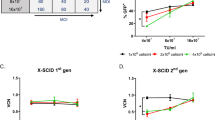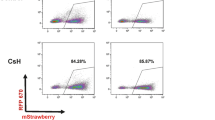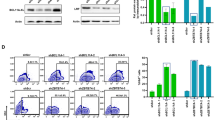Abstract
Genetic modification of hematopoietic stem and progenitor cells has the potential to treat diseases affecting blood cells. Oncoretroviral vectors have been used for gene therapy; however, clinical success has been limited in part by low gene transfer efficiencies. We found that the presence of stromal-derived factor 1 (SDF-1α)/CXCL12 during retroviral transduction significantly enhanced, in a dose-dependent fashion, gene transfer into immature subsets of high proliferative human and murine hematopoietic progenitor cells. Murine mononuclear bone marrow cells and purified c-Kit+Lin− bone marrow cells were prestimulated and transduced with the bicistronic retroviral vector MIEG3 on Retronectin-coated surfaces in the presence and absence of SDF-1. SDF-1 enhanced gene transduction of murine bone marrow and c-Kit+Lin− cells by 35 and 29%, respectively. Moreover, SDF-1 enhanced transduction of progenitors in these populations by 121 and 107%, respectively. SDF-1 also enhanced transduction of human immature subsets of high proliferative progenitors present in either nonadherent mononuclear or CD34+ umbilical cord blood cells. Transduction of hematopoietic progenitors was further increased by preloading Retronectin-coated plates with retrovirus using low-speed centrifugation followed by increasing cell–virus interactions through brief centrifugation during the transduction procedure. These results may be of clinical relevance.
This is a preview of subscription content, access via your institution
Access options
Subscribe to this journal
Receive 12 print issues and online access
$259.00 per year
only $21.58 per issue
Buy this article
- Purchase on Springer Link
- Instant access to full article PDF
Prices may be subject to local taxes which are calculated during checkout







Similar content being viewed by others
References
Bordignon C, Roncarolo MG . Therapeutic applications for hematopoietic stem cell gene transfer. Nat Immunol 2002; 3: 318–321.
Emery DW et al. Hematopoietic stem cell gene therapy. Int J Hematol 2002; 75: 228–236.
Somia N, Verma IM . Gene therapy: trials and tribulations. Nat Rev Genet 2000; 1: 91–99.
Pfeifer A, Verma IM . Gene therapy: promises and problems. Annu Rev Genomics Hum Genet 2001; 2: 177–211.
Kay MA, Glorioso JC, Naldini L . Viral vectors for gene therapy: the art of turning infectious agents into vehicles of therapeutics. Nat Med 2001; 7: 33–40.
Emery DW, Bodine DM . The third conference on hematopoietic stem cell gene therapy: biology and technology. Mol Ther 2002; 5: 658–663.
Cornetta K, Fan Y . Retroviral gene therapy in hematopoietic diseases. J Clin Apheresis 1997; 12: 187–193.
Hennemann B et al. Efficient retrovirus-mediated gene transfer to transplantable human bone marrow cells in the absence of fibronectin. Blood 2000; 96: 2432–2439.
Dunbar CE . The use of nonhuman primate models to improve gene transfer into haematopoietic stem cells. J Intern Med 2001; 249: 329–338.
Rosenberg SA et al. Human gene marker/therapy clinical protocols. Hum Gene Ther 2000; 11: 919–979.
Kohn DB et al. T lymphocytes with a normal ADA gene accumulate after transplantation of transduced autologous umbilical cord blood CD34+ cells in ADA-deficient SCID neonates. Nat Med 1998; 4: 775–780.
Cavazzana-Calvo M et al. Gene therapy of human severe combined immunodeficiency (SCID)-X1 disease. Science 2000; 288: 669–672.
Hacein-Bey-Abina S et al. Sustained correction of X-linked severe combined immunodeficiency by ex vivo gene therapy. N Engl J Med 2002; 346: 1185–1193.
Dunbar CE et al. Improved retroviral gene transfer into murine and Rhesus peripheral blood or bone marrow repopulating cells primed in vivo with stem cell factor and granulocyte colony-stimulating factor. Proc Natl Acad Sci USA 1996; 93: 11871–11876.
Hanenberg H et al. Colocalization of retrovirus and target cells on specific fibronectin fragments increases genetic transduction of mammalian cells. Nat Med 1996; 2: 876–882.
Hanenberg H et al. Optimization of fibronectin-assisted retroviral gene transfer into human CD34+ hematopoietic cells. Hum Gene Ther 1997; 8: 2193–2206.
Kiem HP et al. Improved gene transfer into baboon marrow repopulating cells using recombinant human fibronectin fragment CH-296 in combination with interleukin-6, stem cell factor, FLT-3 ligand, and megakaryocyte growth and development factor. Blood 1998; 92: 1878–1886.
Takatoku M et al. Avoidance of stimulation improves engraftment of cultured and retrovirally transduced hematopoietic cells in primates. J Clin Invest 2001; 108: 447–455.
Wu T et al. Prolonged high-level detection of retrovirally marked hematopoietic cells in nonhuman primates after transduction of CD34+ progenitors using clinically feasible methods. Mol Ther 2000; 1: 285–293.
Abonour R et al. Efficient retrovirus-mediated transfer of the multidrug resistance 1 gene into autologous human long-term repopulating hematopoietic stem cells. Nat Med 2000; 6: 652–658.
Naldini L et al. In vivo gene delivery and stable transduction of nondividing cells by a lentiviral vector. Science 1996; 272: 263–267.
Miyoshi H et al. Transduction of human CD34+ cells that mediate long-term engraftment of NOD/SCID mice by HIV vectors. Science 1999; 283: 682–686.
Woods NB et al. Lentiviral-mediated gene transfer into haematopoietic stem cells. J Intern Med 2001; 249: 339–343.
Sirven A et al. The human immunodeficiency virus type-1 central DNA flap is a crucial determinant for lentiviral vector nuclear import and gene transduction of human hematopoietic stem cells. Blood 2000; 96: 4103–4110.
Case SS et al. Stable transduction of quiescent CD34(+)CD38(−) human hematopoietic cells by HIV-1-based lentiviral vectors. Proc Natl Acad Sci USA 1999; 96: 2988–2993.
Imai K et al. Selective secretion of chemoattractants for haemopoietic progenitor cells by bone marrow endothelial cells: a possible role in homing of haemopoietic progenitor cells to bone marrow. Br J Haematol 1999; 106: 905–911.
Peled A et al. The chemokine SDF-1 stimulates integrin-mediated arrest of CD34(+) cells on vascular endothelium under shear flow. J Clin Invest 1999; 104: 1199–1211.
Bleul CC et al. A highly efficacious lymphocyte chemoattractant, stromal cell-derived factor 1 (SDF-1). J Exp Med 1996; 184: 1101–1109.
Deichmann M, Kronenwett R, Haas R . Expression of the human immunodeficiency virus type-1 coreceptors CXCR-4 (fusin, LESTR) and CKR-5 in CD34+ hematopoietic progenitor cells. Blood 1997; 89: 3522–3528.
Nagasawa T et al. Defects of B-cell lymphopoiesis and bone-marrow myelopoiesis in mice lacking the CXC chemokine PBSF/SDF-1. Nature 1996; 382: 635–638.
Kim CH, Broxmeyer HE . In vitro behavior of hematopoietic progenitor cells under the influence of chemoattractants: stromal cell-derived factor-1, steel factor, and the bone marrow environment. Blood 1998; 91: 100–110.
Zou YR et al. Function of the chemokine receptor CXCR4 in haematopoiesis and in cerebellar development. Nature 1998; 393: 595–599.
Peled A et al. Dependence of human stem cell engraftment and repopulation of NOD/SCID mice on CXCR4. Science 1999; 283: 845–848.
Broxmeyer HE . Regulation of hematopoiesis by chemokine family members. Int J Hematol 2001; 74: 9–17.
Tachibana K et al. The chemokine receptor CXCR4 is essential for vascularization of the gastrointestinal tract. Nature 1998; 393: 591–594.
Lataillade JJ et al. Chemokine SDF-1 enhances circulating CD34(+) cell proliferation in synergy with cytokines: possible role in progenitor survival. Blood 2000; 95: 756–768.
Lee Y et al. Enhancement of intracellular signaling associated with hematopoietic progenitor cell survival in response to SDF-1/CXCL12 in synergy with other cytokines. Blood 2002; 99: 4307–4317.
Broxmeyer HE et al. Transgenic expression of stromal cell-derived factor-1/CXC chemokine ligand 12 enhances myeloid progenitor cell survival/antiapoptosis in vitro in response to growth factor withdrawal and enhances myelopoiesis in vivo. J Immunol 2003; 170: 421–429.
Broxmeyer HE et al. Human umbilical cord blood as a potential source of transplantable hematopoietic stem/progenitor cells. Proc Natl Acad Sci USA 1989; 86: 3828–3832.
Broxmeyer HE . Primitive hematopoietic stem and progenitor cells in human umbilical cord blood: an alternative source of transplantable cells. Cancer Treat Res 1996; 84: 139–148.
Gluckman E . Hematopoietic stem-cell transplants using umbilical-cord blood. N Engl J Med 2001; 344: 1860–1861.
Broxmeyer HE et al. Growth characteristics and expansion of human umbilical cord blood and estimation of its potential for transplantation in adults. Proc Natl Acad Sci USA 1992; 89: 4109–4113.
Broxmeyer HE, Smith FO . Cord blood stem cell transplantation. In: Forman SI, Blume KG, Thomas ED (eds). Stem Cell Transplantation. Blackwell Scientific Publications: Cambridge, 1999, pp 431–443.
Srour EF, Abonour R, Cornetta K, Traycoff CM . Ex vivo expansion of hematopoietic stem and progenitor cells: are we there yet? J Hematother 1999; 8: 93–102.
Piacibello W et al. Engraftment in nonobese diabetic severe combined immunodeficient mice of human CD34(+) cord blood cells after ex vivo expansion: evidence for the amplification and self-renewal of repopulating stem cells. Blood 1999; 93: 3736–3749.
Lewis ID et al. Umbilical cord blood cells capable of engrafting in primary, secondary, and tertiary xenogeneic hosts are preserved after ex vivo culture in a noncontact system. Blood 2001; 97: 3441–3449.
Bajaj B, Lei P, Andreadis ST . High efficiencies of gene transfer with immobilized recombinant retrovirus: kinetics and optimization. Biotechnol Prog 2001; 17: 587–596.
Pollok KE et al. High-efficiency gene transfer into normal and adenosine deaminase-deficient T lymphocytes is mediated by transduction on recombinant fibronectin fragments. J Virol 1998; 72: 4882–4892.
Kuhlcke K et al. Highly efficient retroviral gene transfer based on centrifugation-mediated vector preloading of tissue culture vessels. Mol Ther 2002; 5: 473–478.
Wright DE et al. Hematopoietic stem cells are uniquely selective in their migratory response to chemokines. J Exp Med 2002; 195: 1145–1154.
Broxmeyer HE, Kohli L, Kim CH et al. Stromal cell-derived factor-1/CXCL12 directly enhances survival/antiapoptosis of myeloid progenitor cells through CXCR4 and Gα i proteins and enhances engraftment of competitive, repopulating stem cells. J Leukocyte Biol 2003; 73: 630–638.
Glimm H et al. Ex vivo treatment of proliferating human cord blood stem cells with stroma-derived factor-1 enhances their ability to engraft NOD/SCID mice. Blood 2002; 99: 3454–3457.
Plett PA et al. Treatment of circulating CD34(+) cells with SDF-1alpha or anti-CXCR4 antibody enhances migration and NOD/SCID repopulating potential. Exp Hematol 2002; 30: 1061–1069.
Peled A et al. The chemokine SDF-1 activates the integrins LFA-1, VLA-4, and VLA-5 on immature human CD34(+) cells: role in transendothelial/stromal migration and engraftment of NOD/SCID mice. Blood 2000; 95: 3289–3296.
van der Loo JC et al. VLA-5 is expressed by mouse and human long-term repopulating hematopoietic cells and mediates adhesion to extracellular matrix protein fibronectin. J Clin Invest 1998; 102: 1051–1061.
Quesenberry PJ, Becker PS . Stem cell homing: rolling, crawling, and nesting. Proc Natl Acad Sci USA 1998; 95: 15155–15157.
Verfaillie CM . Adhesion receptors as regulators of the hematopoietic process. Blood 1998; 92: 2609–2612.
Williams DA, Rios M, Stephens C, Patel VP . Fibronectin and VLA-4 in haematopoietic stem cell-microenvironment interactions. Nature 1991; 352: 438–441.
Verfaillie CM, McCarthy JB, McGlave PB . Differentiation of primitive human multipotent hematopoietic progenitors into single lineage clonogenic progenitors is accompanied by alterations in their interaction with fibronectin. J Exp Med 1991; 174: 693–703.
Hynes RO . Integrins: versatility, modulation, and signaling in cell adhesion. Cell 1992; 69: 11–25.
Lataillade JJ et al. Stromal cell-derived factor 1 regulates primitive hematopoiesis by suppressing apoptosis and by promoting G(0)/G(1) transition in CD34(+) cells: evidence for an autocrine/paracrine mechanism. Blood 2002; 99: 1117–1129.
Cashman J, Clark-Lewis I, Eaves A, Eaves C . Stromal-derived factor 1 inhibits the cycling of very primitive human hematopoietic cells in vitro and in NOD/SCID mice. Blood 2002; 99: 792–799.
Richter J, Karlsson S . Clinical gene therapy in hematology: past and future. Int J Hematol 2001; 73: 162–169.
Sutton RE, Reitsma MJ, Uchida N, Brown PO . Transduction of human progenitor hematopoietic stem cells by human immunodeficiency virus type 1-based vectors is cell cycle dependent. J Virol 1999; 73: 3649–3660.
Williams DA et al. Dominant negative mutation of the hematopoietic-specific Rho GTPase, Rac2, is associated with a human phagocyte immunodeficiency. Blood 2000; 96: 1646–1654.
Reid S et al. Enhanced myeloid progenitor cell cycling and apoptosis in mice lacking the chemokine receptor, CCR2. Blood 1999; 93: 1524–1533.
Tao W et al. Profiling of differentially expressed apoptosis-related genes by cDNA arrays in human cord blood CD34(+) cells treated with etoposide. Exp Hematol 2003; 31: 251–260.
Cooper S, Broxmeyer HE . Measurement of interleukin-3 and other hematopoietic growth factors, such as GM-CSF, G-CSF, M-CSF, erythropoietin and the potent co-stimulating cytokines steel factor and Flt-3 ligand. In: Coligan JE et al (eds). Current Protocol in Immunology. John Wiley & Sons, Inc.: New York, 1996, pp 6.4.1–6.4.12.
Acknowledgements
We would like to thank Karen E Pollok and Jennifer R Hartwell for critically reading the manuscript. These studies were supported by US Public Health Service Grants R01 HL 56416, R01 HL 67384, and R01 DK 53674 from The National Institutes of Health to HEB and by a Pilot Project Award from The Core Centers of Excellence in Molecular Hematology, Indiana University School of Medicine to WT.
Author information
Authors and Affiliations
Rights and permissions
About this article
Cite this article
Tao, W., Hangoc, G., Cooper, S. et al. SDF-1α/CXCL12 enhances retroviral-mediated gene transfer into immature subsets of human and murine hematopoietic progenitor cells. Gene Ther 11, 61–69 (2004). https://doi.org/10.1038/sj.gt.3302127
Received:
Accepted:
Published:
Issue Date:
DOI: https://doi.org/10.1038/sj.gt.3302127
Keywords
This article is cited by
-
Sleep disruption impairs haematopoietic stem cell transplantation in mice
Nature Communications (2015)



